|
Polar
Research Today
Archive
of Past Articles
|
Amundsen,
Cook, and Late
Nineteenth Century
Antarctic
Exploration
|
Four individuals, from four nations, played key roles
in the 1897-1899 Belgian Antarctic Expedition
 |
 |
 |
 |
| AMUNDSEN |
COOK |
GERLACHE |
ARCTOWSKI |
‘For his part, Frederick A. Cook deserves
to be remembered for his work on Gerlache’s expedition . . .
the men of the Belgica survived in large part because of the
expertise and character of Frederick Cook’
by Prof. T. H. Baughman
Central Oklahoma University
On October 18, 2007 Prof. T. H. Baughman of the History
Department of the Central Oklahoma University gave
the dinner address at the third annual Workshop on the
History of Antarctic Research at the Byrd Polar Research
Center at the Ohio State University.
The Workshop was supported by the Scientific
Committee for Antarctic Research (SCAR), the Byrd
Center and the German Antarctic Research Group. Dr.
Baughman is the author of
The Last Heroes and other
works on Antarctica. His lecture was sponsored by the
Frederick A. Cook Society as part of the 2007-2009
Centennial of the discovery of the North Pole.
>
READ
THE FULL ACCOUNT
|
Byrd Collection now includes
Library of Congress microfilm of Cook Collection
|

Bookmark from the Research Collections of the Explorers Club in New York City:
items at right include a post card support Cook, the Polar flag of the Arctic Club, circa 1901
and a copy of The Last Voyage of the Miranda.
Raimund E. Goerler, Chief Archivist at the Byrd Polar Research Center of the Ohio State University Columbus, recently acknowledged the $5,000 contribution of the Society towards the archival work of the program.
In a letter to Society President Warren Cook Sr., he wrote:
"As always, it has been a pleasure to work with the Dr. Frederick A. Cook Society and we are excited about your plans for 2008 and 2009. A few weeks ago, we received a grant that will allow us to purchase our own copy of the microfilm of the Dr. Cook collection at the Library of Congress.
So we will soon have a complete collection.
"Currently, we are planning a conference for spring 2007 that focus on IGY and IPY.
Last week we received inquiries from the International Scientific Committee on Antarctica to host an historians meeting in October 2007.
So, there is a flurry of polar activities."
The Frederick A. Cook Collection at Ohio State will thus have the most comprehensive location of all of the works of the explorer, including those deposited with the Library of Congress in 1989 following the death of Janet Cook Vetter, the grand-daughter of the explorer.
Other sites in Hanover, NH (the Steffansson Collection), Hurleyville, NY (the Sullivan County Museum, Cook Collection) and New York City (the Explorers Club) have additional holdings of Cook materials.
Reproduced above is a recent bookmark issued by the Explorers Club Research Archives.
Russians continue their research findings on Cook
|
In September, the popular Russian magazine, Vokrug
Sveta, had a lengthy profile on Cook and his Mt. McKinley and North Polar expeditions, well illustrated and with further evidence that many in the Polar research community and scientific circles in Russia are looking favorably toward the claims of Frederick A. Cook.
The article is by Dr. Dmitry
Shparo, a member of the Polar Commission of the Russian Geographic Society and a colleague of V. S.
Koryakin, of the Russian Academy of Sciences. Dr. Koryakin has researched the
Cook-Peary issues for more than 30 years and was the editor of both the Russian reprints of the Peary and Cook accounts of their respective North Pole expeditions..
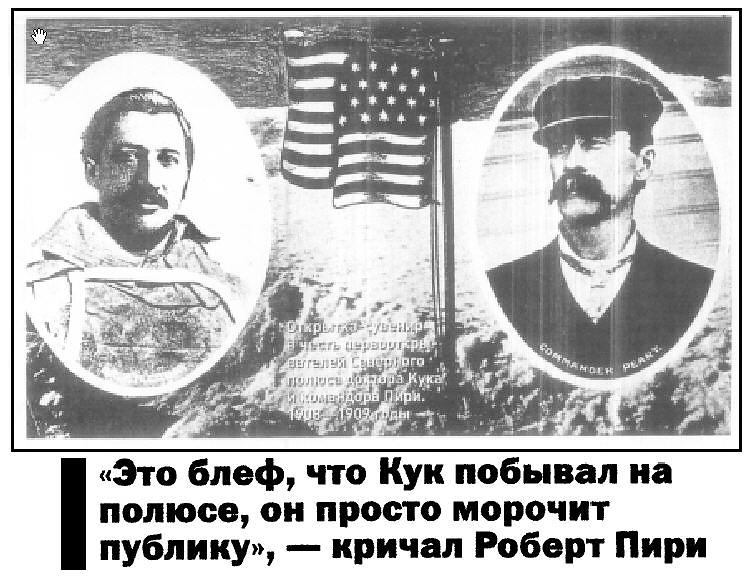
>
READ
THE FULL ACCOUNT
Three
20th
Century
explorers,
one
'mystery'
island
|
|
Frederick
A. Cook (1865 -
1940), Vilhjmur
Stefansson (1879
- 1962) and Hans
Kruger (1886 -
1930?) were three
early 20th century
Arctic explorers
whose careers were
inextricably
entwined with
Meighan
Island.
Stefansson is
acknowledged as its
discoverer in 1916
and Kruger is
presumed to have
perished after
leaving a note in
the island's cairn
in 1930.
Cook's role would
become a significant
sub-dispute in the
larger controversy
involving his 1908 -
09 Polar
expedition.
MEIGHAN
ISLAND MYSTERY
1
Finding Kruger’s
Last Camp?
2 Stefansson’s
Redoubt Collapses
3 The Solution:
Cook’s Vindication
>
READ
THE FULL ACCOUNT
A crucial moment in Cook’s journal
proves him passing 850 30’ North
by
Wayne Davidson
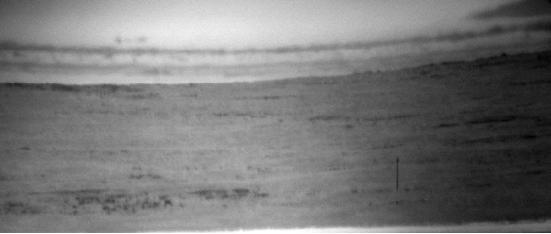
An Inversion caused what appears to be land afar on a western Arctic coastal horizon, really consisting of open water, thin ice and warmer air aloft. There are a few clues which gives away the mirage: note the land profile mimics the apparent distant double ‘landscape’. This is due to an inversion hugging the land horizon at about the same height throughout. Unless a map is available or one goes strait into the direction of the mirage, one can easily assume that there is a big island about 50 to 100 miles away, with also clouds on top.
This is not the first time when Dr Cook’s diary gets dissected, but it will be a first literally showing that he couldn’t have made up his journal on Arctic Ocean ice without actually being there. Astronomers like Denis Rawlins, and Stockwell in 1910, rightfully questioned the veracity of Dr Cook’s claims, as another astronomer correctly stated: extraordinary claims requires extraordinary evidence.
In this case proof comes along as repetition, a key component of applied science. Claims given by Cook must be repeated, otherwise they remain without justification, a tenuous place to be. This essay merely complements my previous verifications on Doctor Cook’s North Pole journey. Sheldon Cook’s conclusion that there was nothing but ice at the Pole as reported by Dr Cook in 1908, is complemented by actual strange sun disk observations that turn out to be equally true, but not only that, true at the location reported.
>
READ
THE FULL ACCOUNT
Sunspots
in the
eyes of
Peary
‘network
navigator’
by
Wayne
Davidson
|
|
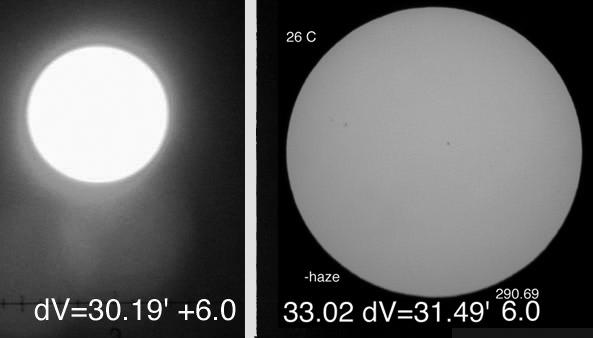
|
Two
sun
shots
at
the
same
6
degree
elevation,
tell
a
different
story.
To
the
left,
Resolute
sun
disk
is
shrunken
by
109
arc
seconds,
temperature
outside
was
about
-20
C.
At
right,
a
Montreal
sun
shot
was
taken
with
higher
resolution
equipment,
it
was
+26
C
temperature,
the
sun
disk
shrank
vertically
by
31
arc
seconds.
2002
was
a
colder
year
than
2003,
sunsets
came
much
later
in
2002.
Peary’s
sun
disk
at
the
North
Pole
in
1909
shrank
by
an
impossible
10
seconds
of
arc,
impossible
because
not
even
a
sun
shot
taken
during
mid
summer
near
Maine,
can
give
this
result.
|
Doug
Davies is
the son of
the
Admiral of
the
Foundation
for the
Advancement
of
Navigation,
backed by
National
Geographic,
dedicated
to refute
Sir Wally
Herbert’s
essay
printed in
their
magazine
in 1989.
But
Admiral
Thomas
Davies
passed
away, I
regrettably
missed
having
this
debate
with him,
I am sure
he would
have found
it
stimulating.
However
Doug turns
out to be
his son,
he decided
to
criticize
my work
with
refraction,
especially
because it
kills any
chance of
Peary ‘s
North Pole
sextant
measurements
to be
true. The
first
section of
his
critique
fails, as
all mean
name
calling
does:
“All
Cook
supporters
are
crazy”
etc, of
course
this
really
explains
why
Peary’s
sun
measurements
were
grotesquely
impossible.
At least
his father
read more
like a
gentleman
with
respect to
Dr Cook.
Doug
Davies has
bad
Internet
manners as
well, like
using
copyright
to claim
intellectual
ownership
of other
peoples
web sites,
even of
Cook and
Peary’s
pictures.
And not
replying
to
E-mail’s
while
using the
content of
those
E-mails
for his
web page.
The man
appears to
have
caught
Peary’s
very own
obsessiveness
with
control
over other
people’s
thoughts.
Atmospheric
refraction
at the
Poles is a
new
subject of
science,
just
breaking
out,
almost 100
years
after Cook
vs. Peary.
To make it
simple,
consider
the sun
disk as
tires on
automobiles.
If it is
very hot
outside
the air
within the
tires
expand and
the tires
look
really
round,
however if
it is very
cold
outside,
say -20°C,
then the
same tires
appear and
are really
flatter.
Polar
Priorities
readers
living in
Cold
winter
areas are
probably
quite
aware of
this. For
similar
reasons,
the sun
disk
appears
flatter in
very cold
air, while
much
rounder in
warm air.
As
explained
in past
P.P.
articles,
the
science
involved
is a bit
complicated.
To make it
simple,
here is
the first
proposed
rule of
sunset
science:
“A
colder
atmosphere
always
causes
significant
upward
refraction
elevation
boost
accompanied
with
vertical
sun disk
shrinkage.”
Except for
sun disks
nearly
touching
the
horizon,
the above
is a law,
unalterable
by critics
or sextant
experts.
Peary’s
own few
measurements
of the sun
disk
vertical
dimension
alleged to
have been
taken at
the North
Pole were
shrunken
by an
average of
10 seconds
of arc.
This is
impossible
for many
reasons:
foremost
it is now
known that
cold air
shrinks
Peary’s
sun disk
by at
least 40
Arc
seconds,
that
authority
is none
other than
the US
Navy, but
in reality
the sun
disk in
Peary’s
time of
much
colder
atmosphere
should
have
shrank by
60 to 120
arc
seconds.
Secondly,
I use a
digital
camera and
telescope
method,
which is
far more
precise
than the
sextant,
it has
never
given the
same
vertical
sun disk
measurement
twice. No
technique
can always
give the
same
vertical
sun disk
measurement,
because
the air
above is
constantly
changing
from one
moment to
the next,
this
phenomenon
is not
significant
enough to
be
perceived
by naked
eyes, but
any
optical
instrument
can show
this.
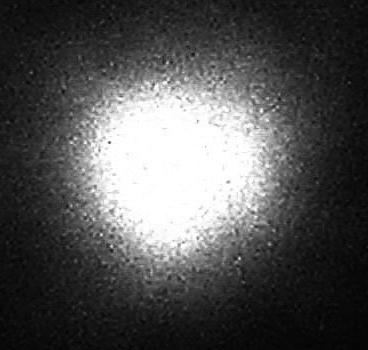 |
Figure
2
blow
up
of
Peary’s
April
6,
1909
sun
from
The
Foundation’s
1989
Supplemental
Report.
It
very
much
looks
like
the
sun
has
a
vertical
diameter
shrunken
in
excess
of
120
Arc
Seconds!
The
vertical
diameter
appears
12
times
smaller
than
Peary’s
measurement.
But
to
confirm
this
one
needs
the
original
pictures.
If
verified,
this
picture
proves
that
Peary
couldn’t
have
measured
a
much
rounder
sun
as
he
claimed
by
his
sextant
measurements. |
But
there is
much more
than just
compression,
Peary
actually
measured a
sun disk
larger
than the
sun disk
itself! 32
minutes 10
seconds.
This is
absolutely
impossible.
To explain
this,
Davies
used a
term
called
standard
deviation,
which is
essentially
an error
factor,
usually
associated
with all
instrument
measurements.
For now,
this error
is 20 arc
seconds,
for
Peary’s
sextant it
use to be
10 (in
1989), but
this
changes
according
to the
intensity
of
challenge.
Even with
this 20
arc
seconds
standard
deviation,
Davies
defense of
Peary
turns
sour,
having a
sun disk
average of
31 minutes
and 57
seconds
(31.95'),
is equally
absolutely
impossible
according
to all
observatories
own Earth.
But to
compound
this
further,
there was
never any
extensive
Polar
refraction
work in
the past,
it turns
out that
refraction
in the
Polar
Regions is
much more
strong
than
estimated.
Peary’s
very
measurement
of the sun
disk
confirms
that a)
didn’t
make a
sextant
measurement
at the
Pole and
b) he
fabricated
it.
Doug
Davies one
time
explanation:
“Peary
rounded
his
sextant
numbers”
so as to
always
achieve
these
impossibilities,
was a
ridiculous
assertion,
and it is
a good
thing he
removed
this poor
defensive
stance
from his
web site.
But Davies
biggest
challenge
is for him
to come up
with a sun
disk
shrunken
at
10"
of arc at
Peary’s
North Pole
sun
elevation
from any
sea level
location
on Earth.
Why did
the 1989
Foundation
for the
promotion
of the Art
of
Navigation
reported
that this
10 arc
seconds
was
“normal”?
Is it
because up
until
1989, it
was some
sort of
scientific
theory? Mr
Davies
also fails
to grasp
that
nowadays,
averaging
differential
refraction
readings
within one
degree
segments
is now an
outdated
method, we
can
compare
many shots
at exactly
the same
astronomical
elevation
in order
to analyze
the
results a
little
better.
Reading
Davies web
site shows
how well
Davies
understands
refraction
and or
meteorology,
he takes
(without
permission)
a quote
from mine:
that Cook
“observed
the sun
with about
5
atmospheres
[of
pressure]
and a
surface
temperature
of -31 to
-44 F, a
great deal
of cold
air.”
the: [of
pressure]
is an add
on from
Davies,
which
demonstrated
his
incapacity
to grasp
concepts
of
distance,
as 5
atmospheres
of
distance,
rather
than
pressure.
If he
would have
corresponded,
like a
gentleman,
he would
have been
taught of
this
essential
concept in
refraction.
Davies
then comes
up to
criticizing
Dr
Cook’s
North Pole
measurements.
They are
to say the
least
fascinating,
nowhere
near what
1908
science
would have
explained,
nowhere
near a
forger
from 1911
can
possibly
imagine.
Dr
Cook’s
sun disk
shrank 5
times more
than I
have ever
measured
in
Resolute
Bay. Yet
again what
was the
Atmosphere
like above
Dr
Cook’s
expedition?
Was the
Arctic
ocean so
frozen
with ice
thick
enough to
dramatically
cool the
atmosphere
well
beyond
present
day Arctic
ocean ice
made much
thinner by
world wide
Global
Warming?
Or were Dr
Cook’s
measurements
flawed? I
don’t
say
forged,
because no
self
respecting
explorer
can come
up with
such
outrageous
numbers.
None more
preposterous
than
seeing the
sun when
it was 4
degrees
below the
horizon,
but this
is
possible,
and
proven*,
and yes
just as Dr
Cook
reported
on his way
to the
Pole in
1908. But
why
didn’t
Marvin nor
Peary
write
about the
same
thing? It
is perhaps
not a
mystery,
but a
concealment.
Peary
(like
Davies)
wanted to
be
credible;
he needed
no
controversies,
seeing the
sun when
it was
well below
the
horizon
was very
controversial.
A true
explorer
calls it
as it is,
a fame
seeker
calls it
as it
should be.
Extreme
shrinkage
of the sun
disk is a
matter
worth
investigating,
but we
must wait
for very
cold air
to make a
come back,
and
perhaps
someone
will take
a few
measurements,
but for
now I
suggest
coastal
Antarctic
colleagues
to take up
the
challenge
during
their
early
Spring .
But
to give a
little
credit to
Davies, he
concludes
that Peary
and Cook
are
essentially
equals in
their
respective
sun
measurements
at the
Pole,
which
means that
neither
can be
certified
without
further
research.
Although,
the
research
with
respect to
Peary, has
been
researched
many times
over, and
there is
not a
chance
that he
can be
vindicated,
especially
in light
of the
cover up
of
Peary’s
data (from
1909 to
1989),
compared
to
Cook’s
very early
information
release.
Both Peary
and Cook
were
explorers,
but Cook
was by far
the most
honest
one,
especially
open for
others to
explore
him, he
was an
explorers
explorer.
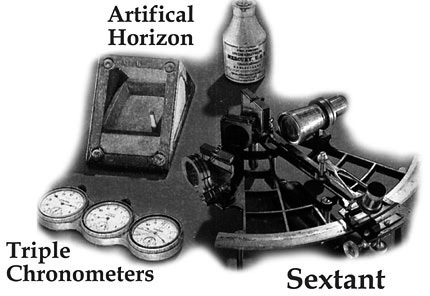
REFERENCES:
Robert
E. Peary
at the
North
Pole. A
report to
the
National
Geographic
Society by
the
Foundatin
for the
Promotion
of the Art
of
Navigation.
Supplemental
Report,
1989.
*
= Applied
Optics-LP,
Volume 42,
Issue 3,
379-389
January
2003
Gerrit de
Veer’s
Ture and
Perfect
Description
of the
Novaya
Zemlya
Effect,
24-27
January
1597
Stebren Y.
van der
Werf,
Gunther P.
Konnen,
Waldemar
H. Lehn,
Frits
Steenhuisen,
Wayne P.
S.
Davidson
ELECTRONIC
REFERENCE:
www.douglasrdavis.com,
My web
pages:
www.ch2r.com
stands for
extremely
high
horizon
refraction
|
Where
All
Meridians
Meet
Cook's
Fantastic
Trip to
the Pole
|
|
-
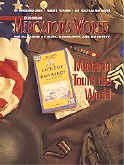
-
|
by Russell
Gibbons
For
much of a
century
(considering
that we
are just
seven
years away
from the
centennial
of the
beginning
of the
North Pole
controversy)
the
"mainline"
literature
that has
addressed
the rival
claims has
generally
tilted
toward a
bias for
Robert E.
Peary, or
dismissed
both
explorers.
Thus
it was
with some
surprise
that we
encountered
the
September/October
2002
number of Mercator's
World, The
Magazine
of Maps,
Geography
and
Discovery
which has
a regular
feature
department
called
"Field
Notes,"
and which
in this
issue
featured
"Where
All
Meridians
Meet:
Cook's
Fantastic
Trip to
the
Pole."
This
proved to
be a three
page
summary of
Cook’s
field
notes from
“My
Attainment
of the
Pole,”
with
entries
from early
April 19,
20 and
21,1908
detailing
the final
approach
and
arrival at
the Pole.
The short
preface to
the notes
is a brief
summary of
the
controversy,
fair and
dispassionate.
(With
one
factual
error:
“Peary,
officially
recognized
by the
U.S.
Congress
in 1911 as
the
Discoverer
of the
Pole...”
is
incorrect.
Congress,
after the
5-4
recommendation
of the
Committee
on Naval
Affairs,
removed
that
designation
and gave
the
“Thanks
of
Congress
for his
Arctic
Explorations
resulting
in
reaching
the North
Pole.”
The
distinction
is
significant,
for many
Cook
supporters
had no
objection
to
Peary’s
claim of
having
reached
but not
having
“discovered”
the Pole.)
The
subtitle
did offer
initial
qualifications,
for
“fantastic”
can be
either
variations
of unreal
or superb,
but any
reading of
the
Mercator’s
piece
would soon
bring the
positive
side of
the word
into play.
It is
worth
checking
out by any
reader.
Coincidentally,
two
contributions
in the
2002 issue
of Polar
Priorities
deal with
Cook’s
field
notes,
that by
Wayne
Davidson
in part
and by
Sheldon
S.R. Cook
as a
significant
point of
argumentation
(the title
was also
in place
before the
magazine.)
Two
other
contributions
in this
number of
the
journal
reflect
the
“field
notes’
of two of
the board
members of
the
Society-
Jim
Garlinghouse
in an
essay
about his
last
ascent of
Mount
McKinley
(Denali)
and Lon
Constantini
in his
account
about a
backpacking
expedition
on Baffin
Island.
Not all
Society
members
are just
“armchair
explorers.”
Discovering
a
Long-Forgotten
Aspect
of
Northern
Studies:
Inuit
and
the
Explorers
Symposium
sponsored
by
the
Society
and
Byrd
Polar
Center
will
have
papers
in
POLAR
GEOGRAPHY
|
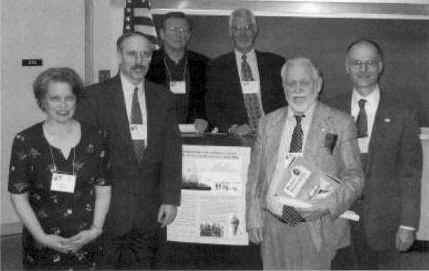
Presenters
at the
Inuit/Explorers
Symposium
held
on
April
20 at
the
Byrd
Polar
Research
Center
at
Ohio
State
University
(from
left):
Patricia
Huntingdon,
Ted
Heckathorn,
Kenn
Harper,
Richard
C.
Davis,
H.G.
Jones
and
Lyle
Dick
(photo
by
David
Kaufman).
In
the North,
explorers
found no
Inca
treasure
or the
fabled
riches of
the
Americas,
but their
quest was
toward
that and
another
goal-the
fabled
passage
through
the
Northwest-following
the
undiscovered
islands
that
bordered
the frozen
northern
coast.
Myth and
legend
propelled
many of
the early
expeditions.
Ship-destroying
channels
and
icebergs
took their
toll and
Sir John
Franklin’s
doomed
expedition
of 1845
became the
classic
flame for
the Arctic
moths that
would
follow. It
would take
almost a
century,
from Sir
John Ross
to Roald
Amundson
to find
and follow
the
Northwest
Passage.
Ironically,
the vast
literature
of the
quest by
North
American
and
European
explorers
of the
19th and
early 20th
centuries
for the
Northwest
Passage
and the
elusive
North Pole
has much
about the
indigenous
peoples
but little
about
their
continuing
inter-relationships
with white
explorers.
The
inevitable
“white
man’s
view of
history”
intrudes
into this
story, as
it has
with most
of the
history of
exploration
and
discovery,
with
little
credit to
native
peoples.
The true
accounts
of
deception,
subjection
and in
many
instances
extermination
of native
peoples in
the
Western
Hemisphere
between
the 15th
and 19th
centuries
remains as
a sordid
and
inglorious,
if less
frequently
told,
chapter of
exploration
and
expansion.
Charles
Francis
Hall, the
obsessed
Cincinnati
printer
who
convinced
Congress
of the
merits of
his
proposed
expedition,
introduced
the Inuit
to the
Western
world as
much as
any
explorer
of that
period.
Recently,
however,
Jean
Malaurie,
who lived
among”The
People”
for many
years
wrote that
“despite
their
seeming
graciousness,
(they are)
hard and
closed,
and their
behavior
enigmatic.”
Russell
Gibbons
Raimund E.
Goerler
Multiple
Sun
Observations
Confirm
Cook
Reached
at
Least
84o
N
New
observations
in
the
high
Arctic
reinforce
Cook's
locations,
while
questioning
Peary's
North
Pole
notes
by
Wayne
Davidson
Upper
Air
Station
Operator,
Resolute
Bay,
Nunavut
|
 |
The
vertical
diameter
of
this
sun
disc
taken
in
the
Arctic
is
flatter
by
a
factor
of
four
times
than
that
which
Peary
measured.
Taken
in
August
2002,
it
can
only
shrink
much
more.
Source:
www.eh2r.com
|
| Ahwelah
and
Etukishook,
Dr
Cook’s
Inuit
exploration
companions,
were
hardened
hunters
of
fame,
people
capable
of
surviving
with
spears
and
arrows
in
the
cruelest
environment
in
the
world.
But
even
for
these
tough
travellers,
nothing
was
ever
so
frightful
as
on
the
Arctic
Ocean
ice
on
March
25,
1908:
“Half-dazed,
I
heard
beneath
me a
series
of
echoing,
thundering
noises.
I
felt
the
ice
floor
on
which
I
lay
quivering.”...”
Ah-we-lah
leapt
to
his
feet.
In
the
same
dizzy
instant
I
saw
the
dome
of
the
snow
house
open
above
me.”
(Dr
F.A.
Cook,
March
25,
1908)
On
March
25,
1908
they
just
passed
the
“Big
Lead”
by a
few
days,
when
all
of a
sudden
the
lead
became
active.
The
Big
Lead
area
is a
treacherous
place.
A
sudden
ice
displacement
is a
known
occurrence
especially
near
the
full
or
new
moon
periods,
lately
more
often
noted,
witnessed
by
several
expeditions,
the
Big
Lead
zone
is
more
understood
but
still
mysterious.
Eighty
years
later
at
about
the
same
date,
just
North
of
Ellesmere
Island,
March
23,
1989
had
moving
sea
ice
which
made
such
a
noise,
frightened
a
young
North
Pole
snowmobile
guide
enough
to
leave
the
Arctic
ocean.
The
Big
Lead
swiftly
opened
that
day,
cracking
hard
ice
to
open
at a
staggering
length
of
about
800
miles
along
the
archipelago
coast,
on
some
spots
the
lead
was
several
miles
wide.
The
lead
closed
the
following
day,
causing
a
huge
noise.
Heard
at
Ward
Hunt
Island
some
40
miles
away,
it
was
like
“continuous
thunder”,
according
to a
British
station
manager.
Once
silence
returned,
the
end
result
was
a
huge
pressure
ridge
as
long
as
the
eye
can
see,
1 km
wide,
10
meters
high,
made
mostly
of
crushed
fresh
ice
stacked
like
myriads
of
shingles
30
feet
high,
it
was
a
living
hell
to
the
expeditions
who
tried
to
cross
it.
Cook
was
therefore
past
the
Big
Lead
when
he
heard
the
frightening
ice
thunder.
This
event
can’t
be
faked
or
manufactured
as a
work
of
fiction,
Dr.
Cook
was
about
at
84N.
A
few
days
prior,
on
March
21
Dr.
Cook
looked
through
his
igloo
ice
glass,
an
igloo
window:
“As
I
awoke
on
the
morning
of
March
21
and
peered
out
of
the
eye-port
of
the
igloo,
the
sun
edged
along
the
northeast.”
Innocent
as
it
seems,
this
statement
proves
his
location.
The
sun
was
about
-4
degrees
below
the
horizon
at
that
time.No
work
of
fiction
could
have
come
up
with
this
apparently
preposterous
story.
A
careful
lie,
would
have
been
double
checked
and
corrected
before
being
published.
On
the
other
hand,
a
full
account
would
and
should
look
a
bit
strange,
since
no
human
had
ever
observed
at
Cook’s
location.
But,
how
did
he
see
the
sun?
A
new
discovery,
I
call
Extremely
High
Horizon
Refraction
(EH2r),confirms
this
observation.
The
colder
the
air,
the
more
refraction
is
created,
the
higher
the
sun
gets
boosted
upwards.
Other
similar
observations
can
be
found
in
history,
the
most
famous
one
was
Gerrit
de
Veer
with
William
Barents
in
1597.
More
recently
the
sun
has
been
frequently
filmed
at
-2
degrees
below
the
horizon,
while
one
photo
from
1987
shows
the
sun
above
ground
when
it
was
-4.5
degrees
below.
Concordingly,
Dr.
Cook’s
temperature
on
March
21
was
-63
F,
extremely
cold
weather
boosted
the
sun
to
appear
much
higher
that
day.
Admitting,
as
some
historians
claim,
that
Dr.
Cook
never
ventured
northwards
past
the
tip
of
Axel
Heiberg
is
discounted
,
for
he
was
well
on
his
way
to
the
Pole,
as
he
claimed.
Finally,
March
28,
at
84
42'
North
Dr.
Cook
wrote:
“Midnight;
north
cloudy,
but
the
ice
bright;
many
hummocks.”
Again
another
innocent
statement,
but
crucial
information,
the
sun
was
-2.2
degrees
below
the
horizon
at
that
moment,
but
thanks
to
strong
refraction,
the
sun
was
above
sea
ice.
Despite
clouds
the
ice
was
bright.
It
is
common
for
the
below
the
horizon
sun
to
be
boosted
by
about
2
degrees
elevation
in
the
high
Arctic.
There
is
more
evidence
supporting
Cook,
but
for
now,
it
is
safe
to
say
he
was
at
84
42 N
or
Northwards.
Crucial
research
with
Differential
Refraction
is
underway
at
this
time.
Differential
Refraction
is a
study
of
the
flattening
of
the
sun
or
moon
by
air.
In
our
case
it
is
very
cold
air
which
shrinks
the
sun
to a
line.
From
its
known
vertical
diameter
in
space,
about
32
minutes
of
arc,
the
sun
shrinks
vertically
to a
line
less
than
6
minutes
of
arc.
At
higher
sun
elevations,
such
as
found
with
Peary
and
Cook
sextant
observations,
the
sun
disk
appears
shrunken
depending
on
how
high
it
is
above
the
horizon.
Peary’s
belated
defense
team,
“The
Foundation
for
the
Promotion
of
Art
of
Navigation”
claim
that
at 6
degree
elevation,
10
seconds
of
arc
compression
is
normal.
But
in
fact
the
sun
shrinks
by
two
minutes
of
arc
or
more
at 6
degrees.
It
remains
to
be
seen
whether
Dr.
Cook’s
observation
can
be
repeated
though,
his
April
1908
observations
indicate
enormous
compression.
More
so
than
measured
today,
but
the
air
during
Dr.
Cook’s
expedition
should
have
been
much
colder
than
present
times.
Peary’s
10
seconds
of
Arc
compression,
can’t
be
explained
in
view
of
present
data;
he
is
off
by a
factor
of
12.
Dr.
Cook’s
sun
disk
observations,
have
not
been
repeated
but
they
show
a
great
deal
more
promise
because
it
is
expected
that
in
very
cold
air
the
sun
disk
image
compresses
a
great
deal
more.
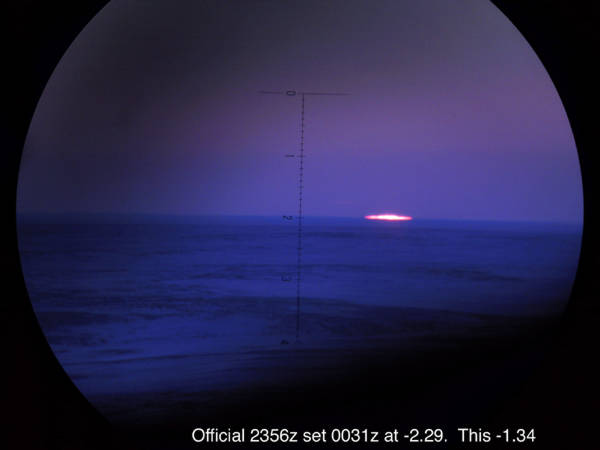
This
March
15,
2002
sunline
had
another
before
it
set
at
2.29
degrees
below
the
horizon.
Sun
is
flatter
vertically
compared
with
horizontal
measurement.
March
15
2002
sunline
had
another
15
minutes
to
go
before
sunset.
The
official
sunset
time
was
wrong
by
35
minutes.
No
Navigation
table
or
program
can
calculate
High
Arctic
sunset
times.
|
|
|
| Robert
Bryce and his
Hysterical Polar
History
The
junior college
librarian as a
self-proclaimed
polar authority
ignores the work of
others with
pronouncements from
his reference desk
armchair
|
|
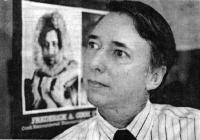 |
by
Ted Heckathorn
Most
history consists
of dates, facts
and information
that are a matter
of record and not
the subject of
debate. There are,
however, a few
disputed events
that have
generated heated
historical
disputes for
decades such as
Pearl Harbor, the
Kennedy
Assassination, and
the North Pole
Controversy. For
over 45 years my
goal had been to
collect all
pertinent data on
the polar issue to
determine if it
could be resolved.
Ten years ago,
with the demise of
Robert E. Peary's
1909 polar claim,
I expressed the
hope that
scientists,
explorers and
historians would
now be able to
examine Dr.
Frederick Cook's
1908 claim in a
dispassionate
manner to arrive
at areas of
agreement.
Unfortunately I
neglected to
anticipate and
factor one
hysterical
librarian's ego
into the equation,
which leads us to
the current
situation.
Recently
Russell Gibbons,
the editor of Polar
Priorities,
advised me that
librarian Robert
Bryce had written
a vituperative,
personal attack on
me in DIO &
The Journal of
Hysterical
Astronomy.
This came as a
surprise because I
had known and
frequently shared
Peary polar
research material
with DIO's
publisher Dennis
Rawlins for over
25 years. Rawlins
had sent me no
advance notice,
opportunity to
respond, or a copy
of the article as
is customary with
reputable
periodicals and
newspapers. The
librarian included
similar ugly
personal attacks
on the Frederick
A. Cook Society,
Russell Gibbons,
and Sheldon S.R.
Cook. Apparently
our collective
crime had been to
question some of
Bryce's pet
theories and write
semi-critical
reviews of his
1133-page opus, Cook
& Peary: The
Polar Controversy
Resolved. In
my case, I had
praised his
research efforts
in finding obscure
archival material,
pointed out some
factual errors and
disagreed with
several of his
conclusions that
were refuted by
data that I found
during many years
of archival and
field research.
>
READ
THE FULL ACCOUNT
| 'Neither
good science
nor good
journalism' |
 |
The
quarter
century saga
of 'DR', the
self-described
skeptic of
history and
science who
comes off as
a loose
cannon among
his peers |
by
Russell W. Gibbons
"It
was after
midnight on a
Saturday night
when University
of Toronto
astronomer Bob
Garrison was
awakened by a
phone call. The
caller
identified
himself as a
member of the
Committee for
the Scientific
Investigation of
Claims of the
Paranormal, and
according to
Garrison, he
spent the best
part of the next
hour urging the
U of T scientist
not to
participate in
[an upcoming]
conference on
astrology."
Canadian
Science Forum,
July-August,
1978
The
caller was
Baltimore
astronomer Dennis
Rawlins.
Essentially the
same account was
earlier reported
in Britain's New
Scientist
magazine (June 28,
1978), which also
asserted that
Rawlins was
engaging in some
free speech
suppression, a
charge which he
would strongly
deny. Yet the
planned conference
on astrology and
science at the
university which
had been well
received in
advance was
subsequently
canceled.
This
incident, which
took place almost
a quarter of a
century ago, was
somewhat of a
symbolic launching
of a career of
unofficial
debunking and
scientific
skepticism for DR
as he calls
himself which
would follow a
tortured path of
interior dissent
with fellow
skeptics,
intemperate
publicity
assaults, and
self-publication
of his ranting
under the covers
of an odd little
magazine called DIO.
In
time, Rawlins
would be
unceremoniously
booted out of the
organization he
had become a
director of, the
Committee for the
Scientific
Investigation of
Claims of the
Paranormal (CSICOP),
which charged that
he
"demonstrated
his inability to
distinguish
between official
(Committee)
actions and those
of its individual
members."
Others in CSICOP
charged that
Rawlins had
"unleashed a
rambling
harangue"
against the
organization.
Philip
J. Klass, a
onetime colleague
of Rawlins, had an
extensive essay
which was printed
in the Rational
Inquirer in
October 1992,
dealing with
Rawlins from the
perspective of
"those of us
with first hand
experience in
trying to work
with him and who
are familiar with
his
modus-operandi."
Indeed the Rawlins
"MO"
would be the
central issue in
his attacks
against onetime
associates in the
Skeptical Inquirer
community and in
his venture into
polar and
mountaineering
history and his
invective in
attacking such
explorers as
Frederick A. Cook
and Richard E.
Byrd.
"After
three years of
working with
Rawlins, I was
well aware of his
proclivity for
making harsh,
exaggerated
charges,"
wrote Klass,
adding that
"most often
these were
directed against
supporters of the
para-normal, but
sometimes also
against Council
members who
disagreed with his
proposals for
intemperate action
against the
'believers.'"
Others have been
harsher: Michael
Gauquelin, a
French
psycho-physiologist,
publicly accused
Rawlins of
distortion and
misrepresentation
in a 197778
dispute involving
both of them that
involved the
CSICOP as an
organization.
With
me or against me
DR
soon earned a
reputation among
his fellow
skeptics as an
all-or-nothing
guy. If you agreed
with him then you
were among the
fortunate
intellects who
were on the side
of Truth. If you
had doubts, you
were consigned
with the enemy.
For the majority
of years in
Western thought,
it has been
characteristic of
historical and
scientific
controversy for an
opposition to
challenge or
question another's
interpretation of
the data.
That
in itself is
accepted in the
scientific
community, yet it
is that which has
on occasion
enraged DR, which
CSICOP Chair Prof.
Paul Kurtz said
had caused
"Rawlins
unleashing a
rambling
harangue"
against the
leadership of
CSICOP, suggesting
that Rawlins
should "skip
the
invective" in
his extensive
memoranda to the
organization, and
instead
"outline the
problem clearly,
concisely and
offer your
recommendations."
One of his memos
Kurtz said,
"was an
unintelligible
jumble."
The
jumble may have
been a trail that
DR initiated when
he convinced his
editor at Luce, a
then New York
publisher, to
allow him to use
eleven pages of
notes and source
citations in his
uniquely
unintelligible
format as a reader
"help"
in the back of his
book Peary:
Fact or Fiction.
This jumble under
hard covers would
be a challenge to
any serious
student of the
controversy,
ignoring standard
reference
citations and
bibliography
format. Indeed, it
may be appropriate
that DR lists a
World War II
expert on
cryptography on
the inside cover
of his DIO
magazine as a
resource person.
The
crux of the DR
conflict with the
Skeptics was his
article in a
publication that
long had been
considered a
favorable outlet
for para-normal
opinion, a popular
digest-format
monthly called Fate.
In the October
1981 issue, DR
went after CSICOP
with both barrels,
declaring that a
"cover-up"
had taken place in
the organization
because it
published a
European
researcher who had
also been the
object of a
spurious Rawlins
attack. DR had
titled his assault
"sTARBABY,"
a play on words
that he enjoys,
incorporating the
dispute in
question
(involving the
so-called
"Mars
Effect" on
birth cycles of
sports achievers).
Kurtz replied with
an essay targeted
to DR, called
"CRYBABY":
There
was no cover-up,
except in Rawlins
troubled mind, fed
by the fires of a
wounded ego, and
perhaps by
embarrassment over
his unauthorized
intervention in
the University of
Toronto
symposiumRawlins
imagines many
things that simply
are not true [he]
chooses to rely on
his vivid
imagination or
recollections
rather than to
take time to check
the factsRawlins
decided he knew
the answer without
bothering to
investigate. This
is neither good
science nor good
journalism.
Without
a more extensive
replay of the
dispute between DR
and his one-time
associates in the
organization, it
may be worthy of
note to recall
that the
academics,
editors, authors,
physicists,
astronomers and
other critical
thinkers who made
up the CSICOP had
a mail ballot to
drop DR from its
"Fellows,"
its top level of
membership. The
vote was 6 to 1.
'DIO'
we believe him or
'DIO' we not?
DR
interspersed his
independent
scholarship (this
is the term for
those who work off
grants or who are
independently
wealthy and can
afford not to have
a real "day
job") in the
war with the
skeptics between
his 1973 Peary
book and his late
80s re-entry into
polar history, in
which he received
national attention
through his
charges regarding
explorer Robert E.
Peary. Ironically
it was the same
years in which
British explorer
and polar author
Wally Herbert made
allegations
regarding Peary.
The
National
Geographic
Society, virtually
the last support
group for his
North Pole claims
other than Peary's
family, came to
his defense again
and commissioned
Herbert to do an
article on the
issue. Herbert
did, and concluded
that Peary had
been 130
geographical miles
short of his goal.
Rawlins had
earlier announced
that he had
discovered the
"Bowman lock
box," a
"do-not-open"
source attributed
to a one-time
president of Johns
Hopkins
University. DR
said it would
shoot Peary's
claims down, but
instead according
to Baltimore
magazine (July
1989), Rawlin's
"smoking
gunhad blown a
hole in his
foot."
Never
one to shy away
from the media, DR
quickly held a
press conference
at the National
Geographic Society
which was similar
to his using Fate
magazine to attack
astrology-bashing
fellow travelers
to acknowledge
that what he had
purported to be
Peary's
navigational
calculations were
in fact serial
numbers of his
chronometers.
"My
interpretation has
some problems, and
I acknowledge
thatI think I have
not yet met the
burden of proof of
saying that Peary
was a fraud."
Others, though,
had met that
burden: Herbert
was acknowledged
as an experienced
ice traveler,
whose assessment
of Peary was
measured, detailed
and conclusive.
DR's
attack on
Frederick A. Cook
can be traced to
his 1973 book. His
initial assessment
of Cook advocates
as "well
meaning but
misguided
folk" evolved
into endless
vitriol by 1998
when his DIO,
subtitled The
Journal of
Hysterical
Astronomy
launched into a
tasteless, vicious
and ranting attack
on Cook, his
supporters and
those in the
history and
scientific
community who had
dared to support
his polar
achievements. It
was a polar "tarbaby"
recalling his
earlier rants with
the skeptics.
Kevin
McManus, a
Baltimore writer
familiar with
Rawlins who
authored an
extensive essay
about DR after the
Peary-NGS flap,
wrote in the city
magazine that
Rawlins "has
practically made a
career oftrashing
other people's pet
theories" and
had led many of
DR's
contemporaries to
suggest that his
MO was as "an
obnoxious,
glory-starved
showboater."
The DR/MO
continued into
recent months when
another special
"double
publication"
of DIO
offered another
attack on Cook and
a new assault on
the achievements
of Rear Admiral
Richard E. Byrd.
DIO
followed the same
pattern of DR and
the Skeptic wars
of the early 80s:
ridicule,
rhetorical excess,
and to quote his
new associate
Robert Bryce
"a general
disdain for those
who do not agree
with him."
Byrd advocates,
and especially the
scholars and staff
at the library and
archives of the
Byrd Polar
Research Center
were dismissed as
"for the
Byrds."
Examples of the
infantile DR
pepper DIO
Byrd issue vol.
10, January 2000
(in typical
Rawlinese
distribution mode,
mailed in August
2001): "kook
elusiveness"
(p. 102),
"crimson-mugged
genii",
"nuts, sluts,
Grosvenors &
clones" (p.
104). That level
of scholarship may
be why DR is
dismissed the way
his hometown
magazine described
him 12 years ago:
"an
intellectual
swashbucklerand
gadfly."
DR,
invited as a
presenter to one
FACS/Byrd Center
symposium in 1993
and an individual
participant in
another in 1997,
chose to be an
observer in the
scheduled debate
between Robert
Bryce and the
Society's Sheldon
S.R. Cook. Now he
asks for debate
despite the fact
that McKinley
associate Bradford
Washburn never
showed for a 1996
debate and in a
"Rodney
King-like"
letter to Society
President Warren
Cook Sr.
(September 15,
2001) asked that
Society members
need only recant
their "belief
system" in
Cook and then
would be eligible
to join DR in a
true celebration
of
"unquestioned"
Cook achievements.
A
final note: Ted
Heckathorn
described by DR as
"a Seattle
historian,
formerly of US.
Intelligence,
[who] must now be
ranked among the
immortals of the
Cook-Peary
Controversy"
(DIO, vol.
6, 1992) was
termed in the same
DIO this
year as an
"amateur
researcher."
This DIO
flip-flop may be
less a fatal flaw
in the
publication's
secretive,
insider-mentality
in which they mail
the printed final
version to the
people they trash.
Any journal worthy
of that name would
have advised those
under extensive
critical treatment
that this was the
case, and that
they would have an
opportunity to
respond. How
hysterical can you
get?
'DIO'
Lament: Reference
works seek out the
'wrong' experts
for national
biography
Robert
Bryce, DIO's
new essayist, has
many hand-wringing
laments in his
72-page
"Response,
not a
defense"
contribution in
the December 1999
(vol. 9, nos. 2-3
printed in June
and distributed in
August 2001)
number of DIO,
then still the
official subtitled
Hysterical
Journal.
One
of the most
telling, however,
may be his angry
notation on page
68 that two of the
DIO nemesis
on Cook and Peary
(the
"amateur"
researchers and
historians as
Bryce describes
them) are not
consigned to the
ashcan of unknown
"cultists"
by the leading
reference works of
North America.
Indeed, quite the
opposite.
The
American
National Biography,
a 24-volume
reference work
published by
Oxford University
Press under the
auspices of the
American Council
of Learned
Societies, was in
the works for a
decade. The New
York Times
said when it was
released in
January 1999 that
it had
"created a
comprehensive
portrait of
American
history."
When
the ANB was
released, the
Council said that
it "is
informed by the
most recent
historical
scholarship and
reflects an
unprecedented
level of
diversity, making
this reference
work the most
modern, inclusive
dictionary of
American biography
ever
produced."
One would think
that such a
production, with
17,450
biographies, would
gladden the heart
of any reference
librarian.
Apparently
not librarian Bob,
who complained of
a "scholarly
standard" in
the selection of
contributors. Why?
Amateurs such as
Ted Heckathorn and
Russell Gibbons
were asked to
contribute the
biographical
profiles on Robert
E. Peary and
Frederick A. Cook.
DR, offering
himself as a Peary
expert for a
quarter century
was ignored.
Possibly
that was the case
because editors
look at
dispassionate and
objective research
in selecting
"informed
scholarship."
They might not
consider the
Rawlins tirades in
print worthy of
consideration (ie.
p. 34 in DIO,
9:2-3, December
1999: "the
Cook crowd's
argumentation-methods
and cult-religious
mental
impenetrability
toward incoming
disconfirmatory
evidence").
So
was Bryce, whose
Cook-Peary opus
came out while the
DAB was in the
works and whose
book presumably
was noticed by
those who set the
"scholarly
standards" at
Oxford and the
ACLS.
|
|
|
The
Tragedy of Pioneer
Black
Explorer Matthew
Henson |
|
 |
A
recent revisionist
school of black
history has
Matthew A. Henson
as the true
"discoverer"
of the North Pole,
or at the least
the
"co-discoverer"
with Robert E.
Peary.
These revisionists
ignore the fact
that for nearly 20
years in the
Arctic, Henson
endured as Peary's
"manservant,"
later to be
discarded by the
man who took all
the "glory
and honor."
In later life
Henson received
belated
recognition, then
a sad exploitation
after his death.
A
web site dedicated
to Henson is full
of false
assertions and
calumny,
especially toward
Frederick A. Cook.
"Certain (
Afro-American) web
sites are on the
edge in terms of
legitimacy,"
declares a
Columbia
University black
studies professor,
offering caution
toward such web
sites. Read
about Henson's own
account of the
alleged trip to
the Pole and his
rejection by Peary.
"Co-discoverers
or
co-conspirators?"
asks one Polar
historian.
READ
THE FULL ACCOUNT
|
Copyright - The Frederick A.
Cook Society
|